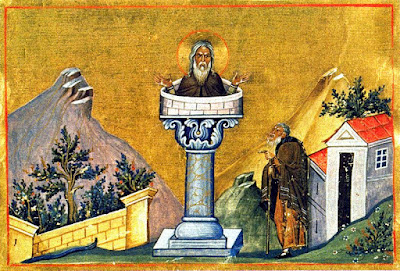A pillar of society in a society of pillars
Much of my scholarly research over
the years has concerned the relationship between monastic thought and practice
and general artistic and cultural developments in medieval Europe. Just recently I have been engaged in
preparing some lectures on the theme of “Asceticism and Literature in the
Middle Ages” to be delivered at Notre Dame University within the next
month.
Some of the points I intend to make
in my lectures so far, though I shall do my best to dignify them with an
earnest rhetoric, do not exactly rise to the level of rocket science. If a society first creates a highly
distinctive tribe, separates it with artifice from the much larger populations
surrounding it, and finally gives it an effective monopoly on the skills of
literacy, it is not particularly surprising that the tribe will have a
considerable impact on the development of that society’s literature. The “tribe” to which I am referring, of
course, are the Christian ascetics—monks and nuns, hermits, consecrated
virgins, friars, brothers and sisters in an astonishing variety of formal or
informal religious “orders.”
I personally have great difficulty
in understanding how the ascetic mind became paramount in nascent
Christianity. Jesus said that all of
Torah could be boiled down to two propositions: love God, love your
neighbor. These were called the “Two
Great Commandments”. The “contempt for
the world” (contemptus mundi, a
formula favored by the ascetics for the better part of two millennia) might be
a valuable tool in achieving a single-minded focus on the First Commandment,
but it seems to me absolutely antithetical to fulfilling the Second. How do you love your neighbor by guaranteeing
that you have as few neighbors as possible, and of that few only like-minded
world-haters like yourself?
Saint Anthony of the Desert,
usually called the first monk, sought incremental sanctification through
incremental isolation. He withdrew first
to the edge of the village, then deeper and deeper into the wilderness to less
and less welcoming shelters, to hollows in the rocks and the abandoned lairs of
wild animals. All the famous early monks
lived in artificial prisons of one kind or another. The stylite saints, the circus freaks of the
monastic movement, spent their lives atop stone pillars.
It is difficult for the modern
mind—and such mind as I have is necessarily modern—to grasp the phenomenon with
mental neutrality, let alone with sympathy. The anti-ascetic bias among historians in the Enlightenment
tradition actually antedates Gibbon, though it is perhaps most brilliantly
exemplified by him. The thirty-seventh
chapter of the Decline and Fall of the
Roman Empire must surely be among the most brilliant monuments of erudite
scurrility in our language. In it Gibbon
delineated two coordinated cultural disasters that fell upon the classical
world—the rise of monasticism and the conversion to Christianity of the
northern barbarian tribes.
More focused is the opinion of one
of my favorite nineteenth-century historians, William Edward Hartpole Lecky,
author of the ever-fascinating History of
European Morals. Unlike Gibbon Lecky
was not a bigot, and he generally avoids rhetorical polemic. Nonetheless he wrote as follows of Anthony
and his eremitical imitators: “There is, perhaps, no phase in the moral history
of mankind, of a deeper or more painful interest than this ascetic
epidemic. A hideous, sordid, and
emaciated maniac, without knowledge, without patriotism, without natural
affection, passing his life in a long routine of useless and atrocious
self-torture, and quailing before the ghastly phantoms of his delirious brain,
had become the ideal of the nations which had known the writings of Plato and
Cicero and the lives of Socrates and Cato.
For about two centuries, the hideous maceration of the body was regarded
as the highest proof of excellence.”
William Edward Hartpole Lecky (1838-1903)
What Lecky does not say, but what I
must try to take account of, is that we would
not know the writings of Plato and Cicero, and we would know precious little of the lives of Socrates and Cato, were
it not for the Christian monks whose legendary founder inspires Lecky’s
indignation. Of course the “hideous,
sordid, and emaciated maniac” to whom he alludes is no other than Saint Anthony
the Great. For the perhaps paradoxical
truth is that practically everything we know about the Ancient World that comes
from documentary sources was copied, preserved, and transmitted in the religious
houses of Europe. I have seen a
thirteenth-century manuscript of Ovid’s Remedia
Amoris to which the monastic scribe appended a prayer of thanksgiving to
the Virgin Mary for her aid in helping him complete his task.
Twenty years ago the popular
historian Thomas Cahill made a notable success with a book entitled How the Irish Saved Civilization. The claims of the book, like its title, were
perhaps a little hyperbolic, but its gist is undeniable. It’s rather amazing just how much emaciated
maniacs could achieve when they set their minds to it.


Perhaps the motivation for asceticism came from some other words of Jesus. When the rich young man approached Jesus and asked what he could do to attain eternal life, Jesus told him to keep the commandments. When the man replied that he had done so all his life, Jesus looked at him with love and said, "if you would be perfect, sell what you have, give to the poor, and come follow me."
ReplyDeleteI've enjoyed your post and got some valuable tips from your article.Thank you for your post.
ReplyDeletekimera